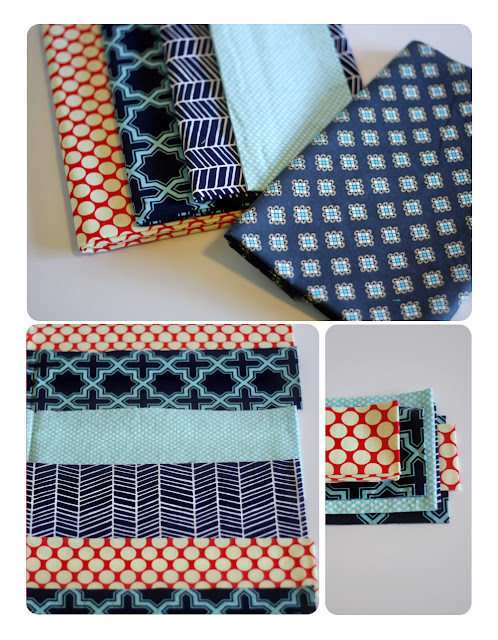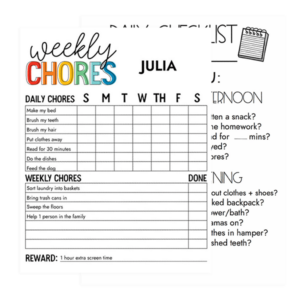Hi guys!
I’m back this week with the tutorial on how to make the patchwork placemats I showed you 2 weeks ago.
Like I said before, I love this project. I love it’s simplicity for a beginner, but the versatility and speediness for a more seasoned seamstress. I’ll even give you a few ideas at the end of the post on just what else you can create with this basic patchwork technique.
Let’s get started::
Patchwork Placemats {Set of 6}Finished Size: Approx. 13″x17″
Materials:
- Fabric A 3/8 YD
- Fabric B 1/2 YD
- Fabric C 1/4 YD
- Fabric D 3/8 YD Fabric E {Backing/Binding Fabric} 1 3/8 YD
** All of your Fabrics A-E need to be the full width of fabric {WOF} not fat quarters. **
- Batting ~ enough to cut {6} 13″x17″ rectangles
- Coordinating thread
- A rotary cutter, cutting mat and ruler will make your life MUCH easier.
Cut Fabrics A-E as follows::
- Fabric A – Cut {2} 3.5″xWOF & {2} 2.5″xWOF strips / 4 strips total
- Fabric B – Cut {2} 3.5″xWOF & {2} 3″xWOF strips / 4 strips total
- Fabric C – Cut {2} 3.5″xWOF / 2 strips total
- Fabric D – Cut {2} 4.5″xWOF / 2 strips total Fabric E – Cut {3} 16″xWOF / 3 strips total
** I use the term WOF and not a measurement as all fabric manufactures are a little different. The industry ‘standard’ is that mostfabric is about 45″ from selvage edge {the finished/non-cut edge} to selvage edge with is considered the width-of-fabric {WOF}. **
Taking one of each of the strips you just cut from fabrics A-D {i.e. {1} 2.5″ & {1} 2″ strip of Fabric A}, arrange them in an eye pleasing way. Once you’re satisfied with the arrangement, stack your strips in order.
Create your patchwork piece::
Begin sewing the first two strips together by laying them right sides {RS} together and pinning along the edge you’re going to sew. Sew the two strips together using a 1/4 seam allowance {SA}. Press OPEN the seams. Continue in this manner, laying the next strip RS together on the ones you already sewed, pinning in place and sewing with a 1/4 SA. Press open the finished seam BEFORE sewing your next strip. This will help keep your seams straighter.
Cut your placemat tops and bottoms::
Once you have all the strips sewn together, you are going to cut {3} placemat tops from this big piece. Your finished big piece will be approx. 18″x WOF. Begin by squaring up {making a nice straight cut} one of the short ends. The short end will measure slightly larger than what we need {we only need 17″}. From the squared up short end, measure 13″ and cut perpendicular to your strips. You should end up with a piece 13″x approx. 18″. Take this piece and square it up to exactly 13″x17″ cutting off the small bit of excess fabric. Repeat for remaining {2} placemat tops.
Cut Fabric E into 16″x20″ rectangles. You will be able to cut {2} rectangles from each strip for a total of {6} rectangles. You’ll have some excess fabric on each strip which you can add to your scrap pile for a later project.
Cut batting into 13″x17″ rectangles. You’ll need {6}.
Repeat above steps for additional strips of fabric {A-D}, so that you end up with {6} placemat tops, {6} placemat backs and {6} rectangles of batting.
Make your ‘layer cake’ for each placemat as follows::
Iron {1} placemat top to {1} piece of batting. These should be the same size. Ironing will help hold them together nicely. Center the top/batting piece on top of a backing piece which is RS down. Once it’s centered, pin each corner and various points along the perimeter and inside.
Straight Line Quilting::
Using a straight stitch, increase your stitching to approx. 3.5. Using your presser foot as a guide, stitch 1/4 on each side of all {5} of your seams, back stitching at the beginning and end of each row. You will be stitching through all three layers {top, batting, bottom}. You may need to use a different color thread in your bobbin to match your back piece {I used cream on top and dark grey in my bobbin}.
**DO NOT stitch on the excess border of backing fabric … only stitch on the layered placemat top.**
Prep your quilted placemat for binding::
Trim all your threads from quilting and press your entire placemat. Trim the excess border of backing fabric to be 1″ all the way around.
Machine Binding::
Following ‘Rae’s Cheater Binding’ tutorial, fold and press your excess backing fabric to create your binding. Stitch binding down as close to the interior edge as you feel comfortable. Make sure you sink your needle down into the fabric before you lift your presser foot and pivot at each corner.
Ta-da!! You’ve just made a placemat!!
Now repeat steps from “layer cake to binding” for your remaining 5 placemats and you’ll have yourself a set of 6!
We don’t use placemats a ton in our house, but I do love using fabric ‘mats’ under things. For example, I’m using my new placemat under my cookie jar/measuring cups which tend to scratch the counter top as they get drug across it. Plus it just looks cute right?
Aside from being a great addition to your home, this would make a lovely wedding or housewarming present.
You could also easily take the basic patchwork piece you first created and cut different sized squares or rectangles to create a:: table runner, pot holders, plant mats, mug rugs or any other patchwork project your heart desires. All you have to do is adjust your backing size to be approx. 1.5″ larger on all sides to give you wiggle room for your binding.
Happy Sewing!
For more Knitty Bitties, you can find me rambling on my Blog; trying to keep connected on Facebook; tweeting on Twitter and most assuredly pinning on Pinterest! Or check out my previous 30days posts here.













Hello there! Do you know if they make any plugins to safeguard against hackers?
I’m kinda paranoid about losing everything I’ve worked
hard on. Any recommendations?
Thanks for the tutorial. That was a real help.
Me encantan son faciles y muy bonitos.Un Saludo
Wooo! These are cute. Thanks Mique. I’ll have to add them to my never-ending ‘To-Do’ List. :)
Oh boy … those stinkin’ to-do lists :). These are FAST though … a perfect weekend project with *almost* instant gratification!
Happy Sewing!
It was a great post. Patchwork patterns range from basic to intricate, the simplest made by stitching together assorted fabric squares of equal size. Thanks for sharing.
Thank you so much for tutorials. It is so kind of you to take the time to do that!
You are welcome! Thanks for taking the time to say that … it means a lot!
Happy Sewing!
Patchwork patterns range from basic to intricate, the simplest made by stitching together assorted fabric squares of equal size..
thanks for this tutorial. I’ve been wanting to make placemats.
That’s what I love to hear … I hope this helps you check that off your ‘want to’ list.
Happy Sewing!
Love this tutorial! Thanks for sharing it. Pinned it. :)
Hurray! Now get sewing :).
Thanks for pinning!